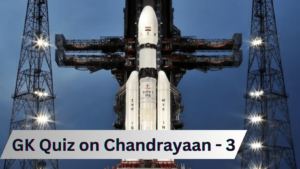Test your knowledge about Chandrayaan 3, India’s lunar mission, with this GK Quiz.
Explore questions about its objectives, launch vehicle, landing site, instruments, and more.
Challenge yourself and learn interesting facts about India’s space exploration endeavors.
Here’s a GK Quiz on Chandrayaan 3 with Answers s and explanations:

GK Quiz on Chandrayaan 3
1. Chandrayaan 3 is the space mission of which country?
a) India
b) China
c) Russia
d) United States
2. Chandrayaan 3 is the successor to which previous Indian lunar mission?
a) Chandrayaan 1
b) Chandrayaan 2
c) Mangalyaan
d) AstroSat
3. Which celestial body is the primary target for Chandrayaan 3?
a) Mars
b) Moon
c) Venus
d) Jupiter
4. The launch vehicle planned for Chandrayaan 3 is:
a) GSLV Mk III
b) PSLV-C11
c) Falcon 9
d) Atlas V
5. Which of the following is a key objective of Chandrayaan 3?
a) Study the atmosphere of the Moon
b) Establish a permanent human settlement on the Moon
c) Search for signs of extraterrestrial life
d) Conduct high-resolution mapping of the lunar surface
6. The Chandrayaan 3 mission is expected to include a:
a) Lunar orbiter
b) Lunar rover
c) Lunar lander
d) All of the above
7. The Chandrayaan 3 mission is scheduled to launch in:
a) 2021
b) 2022
c) 2023
d) 2024
8. The Chandrayaan 3 mission aims to land on which region of the Moon?
a) Mare Serenitatis
b) Mare Tranquillitatis
c) Tycho Crater
d) Lunar South Pole
9. Chandrayaan 3 will carry instruments to study the:
a) Magnetic field of the Moon
b) Topography of the Moon
c) Mineral composition of the Moon
d) All of the above
10. The Chandrayaan 3 mission is expected to contribute to our understanding of:
a) Moon’s origin and evolution
b) Water presence on the Moon
c) Geology of the Moon
d) All of the above
11. The Chandrayaan 3 mission is a part of which larger space exploration program of India?
a) Mars Orbiter Mission
b) Gaganyaan
c) Aditya-L1
d) None of the above
12. The Chandrayaan 3 mission is a collaborative project between India and:
a) China
b) Russia
c) United States
d) None of the above
13. The previous attempt of Chandrayaan 2 included a lunar lander named:
a) Vikram
b) Mangalyaan
c) Pragyan
d) Chandrika
14. Chandrayaan 3 is being developed to demonstrate improved:
a) Landing techniques
b) Orbital maneuvering
c) Communication systems
d) All of the above
15. The Chandrayaan 3 mission is aimed at enhancing India’s capabilities in:
a) Space research and exploration
b) Weather forecasting
c) Satellite communication
d) Defense technology
16. The cost estimation of Chandrayaan 3 is approximately:
a) Rs 1615 crore
b) Rs 15 crore
c) Rs 2615 crore
d) Rs 615 crore
17. The Chandrayaan 3 mission is expected to have a duration of:
a) 10 days
b) 14 days
c) 100 days
d) 104 days
18. The primary landing site of Chandrayaan 3 is located near:
a) The lunar equator
b) The lunar north pole
c) The lunar south pole
d) The lunar far side
19. The Chandrayaan 3 mission aims to land a rover with a mass of approximately:
a) 10 kg
b) 16 kg
c) 26 kg
d) 50 kg
20. The successful completion of the Chandrayaan 3 mission will make India:
a) The first country to land on the Moon’s south pole
b) The second country to land on the Moon
c) The first country to conduct a soft landing on the Moon
d) The third country to reach the Moon’s orbit
About Chandrayaan – 3:
Chandrayaan-3 is a follow-on mission to Chandrayaan-2 to demonstrate end-to-end capability in safe landing and roving on the lunar surface.
It consists of Lander and Rover configuration. It will be launched by LVM3 from SDSC SHAR, Sriharikota. The propulsion module will carry the lander and rover configuration till 100 km lunar orbit.
The propulsion module has Spectro-polarimetry of Habitable Planet Earth (SHAPE) payload to study the spectral and Polari metric measurements of Earth from the lunar orbit.
Lander payloads: Chandra’s Surface Thermophysical Experiment (ChaSTE) to measure the thermal conductivity and temperature; Instrument for Lunar Seismic Activity (ILSA) for measuring the seismicity around the landing site; Langmuir Probe (LP) to estimate the plasma density and its variations. A passive Laser Retroreflector Array from NASA is accommodated for lunar laser ranging studies.
Rover payloads: Alpha Particle X-ray Spectrometer (APXS) and Laser Induced Breakdown Spectroscope (LIBS) for deriving the elemental composition in the vicinity of landing site.
Chandrayaan-3 consists of an indigenous Lander module (LM), Propulsion module (PM) and a Rover with an objective of developing and demonstrating new technologies required for Inter planetary missions.
The Lander will have the capability to soft land at a specified lunar site and deploy the Rover which will carry out in-situ chemical analysis of the lunar surface during the course of its mobility. The Lander and the Rover have scientific payloads to carry out experiments on the lunar surface.
The main function of PM is to carry the LM from launch vehicle injection till final lunar 100 km circular polar orbit and separate the LM from PM. Apart from this, the Propulsion Module also has one scientific payload as a value addition which will be operated post separation of Lander Module.
The launcher identified for Chandrayaan-3 is LVM3 M4 which will place the integrated module in an Elliptic Parking Orbit (EPO) of size ~170 x 36500 km.
The mission objectives of Chandrayaan-3 are:
- To demonstrate Safe and Soft Landing on Lunar Surface
- To demonstrate Rover roving on the moon and
- To conduct in-situ scientific experiments.
Also, Read
Everything About Chandrayaan – 3
GK Quiz on Chandrayaan 2 with Answers
Top 10 Most Powerful Passports in the World
Top 10 Highest Paid Jobs in the World
Top 10 Best Hollywood Movies of All Time










